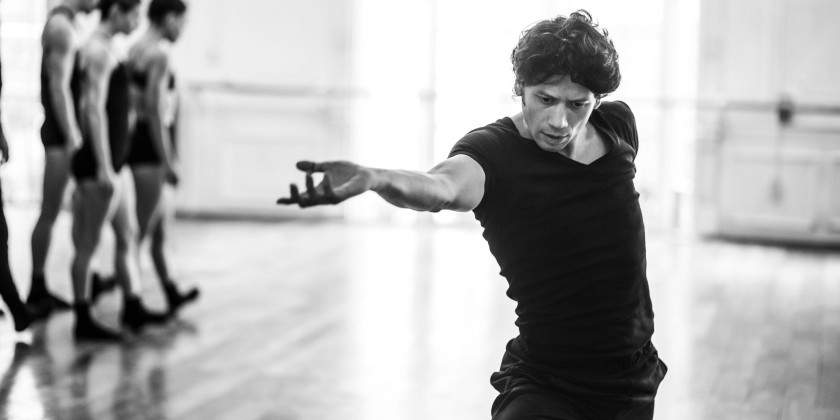IMPRESSIONS: Parsons Dance at the Joyce Theater

A New York Premiere with works by Robert Battle and Kate Skarpetowska
Finding Center, Union, Caught, and Nascimento choreographed by David Parsons
Train choreographed by Robert Battle
Almah choreographed by Katarzyna Skarpetowska
Performed by Sarah Braverman, Ian Spring, Elena d’Amario, Geena Pacareu, Omar Román de Jesús, Eoghan Dillon, Zoey Anderson, Ahmad Simmons
David Parsons thinks like a chef. Using a few key ingredients, he concocts tasteful, easily digestible dances. They satisfy an appetite for the understandable and the relatable in a world filled with contradictions and ambiguity.
In its six-bill A Program (there is also a family-friendly matinee program on weekends) at the Joyce Theater, Parsons Dance keeps the mood breezy. The company showcases three works from its repertoire, a New York premiere, plus pieces from other choreographers: one from Alvin Ailey artistic director Robert Battle and another by up-and-comer Katarzyna Skarpetowska. Both Battle and Skarpetowska are former members of Parsons Dance.
Parsons' artistic ethos has remained markedly consistent after decades of choreographing. In the New York premiere of Finding Center (2015) for six dancers, he uses the bright, smudgy ovals of artist Rita Blitt (the artworks are displayed as a projection) as his kinesthetic inspiration. Sprightly percussion undergirds curving arms and swerving leaps. Splashes of whimsy — jutting chicken heads and bow-legged lopes — poke at the rounded contours.

Like one of Blitt’s ovals, this politely funky vibe loops to the last piece, Nascimento, choreographed twenty-five years earlier. The rhythms, by Brazilian composer Milton Nascimento, evoke umbrella-topped drinks and sandy beaches. The squeaky clean cast of eight in 1950s silhouettes bounds genially, their arms flexed in a touchdown motif. Only one nail-biting moment disturbs the PG fun. Like a cheerleading squad, the group tosses a dancer skyward where she hangs high, high, high in the air.
Parsons' vocabulary delights in in the explicitly impressive: zippy coupé jetés, pitched penchées, and strings of hopscotching footwork. Verticality and its defining force, gravity, appear to be particular preoccupations. Unlike ballet, which seeks to defy gravity with lofty, explosive jumps, Parsons exploits the inevitable. Jumps cut and surge rather than peak. Landings are near invisible and serve to power the next caper.

Nowhere is this fascination with verticality more apparent than in Parsons' masterpiece, Caught (1982). A soloist (a reverent Ian Spring) ricochets through dozens of leaps including stag, split, and a striding one that suggests a man walking on air. At the pinnacle, a strobe light catches the performer while blackness obscures the mundane pliés that fuel the takeoffs and landings. The dazzling effect is of a dancer flying.
Parsons' values lean toward the conventional, the wholesome, the communal, and the lucid. Even in the arguably darkest work, Union (1993), they prevail. A writhing organism of eight dancers wield their arms like slow-motion sabers as they cleave a diagonal from upstage to downstage. Once they arrive in the center spotlight, they bask in its warmth like a cat. Men and women hoist and release each other — a group rippling through some esoteric ritual. Even with the sinister lighting and arty black-and-flesh costumes, Union seems more a meditation on cooperation than something more provocative.

Parsons Dance does what many other eponymous companies do by inviting other choreographers into the fold. Robert Battle and Katarzyna Skarpetowska must crow their good fortune; the performers, particularly the women, of Parsons Dance are formidable. These dancers boast bodies like Helvetica font — commanding and unfussy. In turn, Battle and Skarpetowska present pieces with the clear-cut, community-oriented values of their former boss.
The stage can barely contain the bristling energy of Battle's Train (2008). To the rough, contagious drums of Tambours du Bronx, an insolent sextet walks, which is to say they scamper, they strut, they swagger, and they skitter. In between these variations on perambulation, they plummet to the floor with crimped limbs and hurl themselves into flashy extensions. Elena d’Amario crackles in a longish solo; her feet smack the floor like a gypsy and one arm churns in reckless circles.
Skarpetowska’s world premiere of Almah is the freshest breath of air. Three men and three women swirl to the folky, brassy compositions of Ljova played live. Skarpetowska has a keen sense of rotation. The steps — swinging rond de jambes, whizzing barrel rolls, underarm turns for the women led by the men — aren’t revolutionary, but how they are organized electrifies. Everything winds and unwinds like an endless whirligig, sucking the dancers and us into its cyclonic power. I want to join this community.
Share Your Audience Review. Your Words Are Valuable to Dance.
Are you going to see this show, or have you seen it? Share "your" review here on The Dance Enthusiast. Your words are valuable. They help artists, educate audiences, and support the dance field in general. There is no need to be a professional critic. Just click through to our Audience Review Section and you will have the option to write free-form, or answer our helpful Enthusiast Review Questionnaire, or if you feel creative, even write a haiku review. So join the conversation.














